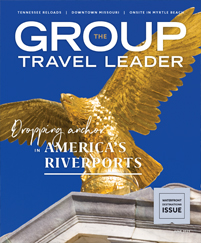
Courtesy International Expeditions
Claudia Mansfield Sutton
Executive Director
Student Youth Travel Association (SYTA)
Peter Pantuso
President and CEO
American Bus Association (ABA)
Lisa Simon
President
NTA
John Stachnik
Chairman
United States Tour Operators Association (USTOA)
With an economic recovery hopefully underway, do you expect to see any reversal of travel trends from 2008 to 2010? Will things like short booking windows, smaller groups and price discounting return to normal with a recovery, or are they here to stay?
Pantuso: Some of those things are here to stay. We saw some of those trends as far back as 2001. We saw people waiting until the last minute, waiting to see if everything was OK, waiting for a deal. I believe people will continue to do that. With the Internet and everything being “right now” today, people are planning their tours that way.
I spent all of last week in the eastern part of Tennessee touring around via motorcycle. I had a chance to talk to dozens and dozens of travel partners there, and what I found was sort of all over the park. Some folks are seeing groups that are getting smaller and more cancellations, and others say their numbers are holding very solid.
Operators say that as they’re putting a trip together, they have to find a way to make that trip new and fresh. It may be the same destination but a completely new package and product. Some operators work very well with a local CVB or receptive to make the destination different. But we also have a lot of folks in the industry who are operating the same trips they did in the past and seeing a decline in the people that take them, and they wonder why. It clearly says that you’ve got to find a way to keep the product new, fresh and different.
Simon: Will things go back to the way they were? I don’t think so. I think the new norm is constant change. Booking cycles have been getting shorter and shorter for years. It’s a longer-term impact, because it’s a sign of the changing consumer and the impact that the Internet has had on our lives.
Smaller groups have been a change for many years, which I think is a direct result of the value of travel packages. Some traditional groups have gotten smaller, but some people who have traveled independently before are buying packages and expanding into smaller groups. So it’s something that tour operators could take advantage of.
Discounting is a tough one. We’ve already begun to see less direct discounting, although there wasn’t across-the-board discounting. A lot of our tour operators held their prices but also offered different products. I think discounting was driven by the cruise lines, and that’s going to continue to drive prices.
Stachnik: In 2010, the trends have started reversing themselves. The standard by which everyone is judging themselves in USTOA is how we’re doing in comparison to 2007. We haven’t recovered all the ground, but we see light at the end of the tunnel.
The short booking window, thanks to the Internet, is here to stay. The operators have learned to live with that, and they’re making it part of their marketing strategy. Now people have their passports in hand, and they’re buying more sophisticated programs less time out, because they feel there’s an opportunity for it.
Groups are becoming smaller. Seventy-five percent of people are not changing their travel plans, but that means that we could be down 25 percent. Groups are 25 percent smaller than they were two to three years ago. But I think it will come back as consumer confidence comes back.
Invention is the mother of discovery, and price discounting filled a necessary need. Like the airlines are doing less lift, you’re seeing operators cut down inventories as well. The need for discounting was bigger when they had excess inventory booked, but less inventory means less discounting.
Sutton: I think there’s an economic recovery beginning to emerge. But the effects of the recession may last a while longer, especially in the schools. The schools are forward funded, so the effect on that may be different than in other industries.
Many of our schools plan their travel cycles and budgets a year in advance, especially things like performance travel, annual senior trips and history trips. They have not been as affected by the recession as one might think.
Discounting is the last thing to recover from any recession. People get used to lower prices, and it’s hard to get them back to regular prices without alienating them. In this recent recession, many of our members created additional ways for them to save money while still providing rich travel experiences for students. They are using less expensive hotels, offering more complimentary activities and alternative, less expensive destinations.
How is your organization addressing the disaster on the Gulf Coast both in the short term and the long term?
Simon: When we started looking at what they really need in the area, we were trying to figure out what we could do that would offer them some practical and tangible benefit. So our chairman, Cathy Greteman, put out a challenge to tour operators to bring more tours to the Gulf, now and in 2011.
We’ve had a really good response. We’ve had several tour operators who have committed to it and planned trips to the area for this year and committed to them running. We had one of our tour operator board members go out to her group leaders and share the challenge with them.
In conjunction with Edelman Worldwide, we’ve offered seminars on crisis management and media relations for businesses on the Gulf. It’s the local businesses in the travel industry and some that aren’t in the travel industry. The seminar was to talk about the best practices through crises, how to rebuild business and how to leverage the media that come in, get their story and get out.
Pantuso: We have continued to try to put messages out there from our partners in the Gulf region. We have a segment up on the website where we’re quoting local CVBs and tourism offices. We as an industry need to rally around our colleagues and members.
The Gulf Coast is a great destination. Unlike a hurricane, everything is still there, and there are still some great opportunities. The stretch of beach that is affected goes inland maybe 5 to 10 feet, depending on the tides, but the rest of the beaches are still beautiful. It’s a marketing challenge, but there are great opportunities to get groups down there to see it. We’ve asked our members on Facebook and other social media sites to get out there and let others know what’s going on.
Sutton: Our membership responds really quickly and strongly to students and youth who have been affected in any kind of tragedy. We have the SYTA Youth Foundation, and when Katrina hit, the foundation started the Silver Lining program for children who are in an area affected by some kind of tragedy. It’s not possible at this time to see the full impact of the oil spill, but over time, our members could band together and help those students.
Our Gulf Coast members are just starting to get inquiries about tours in 2011 that would allow students to help with cleanup. It’s the opportunity for students to be on a trip but also volunteer to help with the recovery.
Stachnik: Beach holidays are an integral part of the makeup of many USTOA tour operator products. We have no formal initiatives like the seminars that NTA is doing, but what we’ve seen is that our members are working closer and closer with the CVBs.
There was a wonderful story in “USA Today” [recently] about how the clear waters of St. Petersburg Beach have not been affected. The PR people and the marketing people are hitting that message long and hard on behalf of the Gulf Coast. There’s a mutual awareness that we shouldn’t let this market diminish because of too enthusiastic reporting.
If travel restrictions to Cuba are lifted soon, how will that affect your association and its members? Would Cuba become an important destination for your constituents?
Simon: I think Cuba will be an extremely important destination, because it’s a brand-new product. No one has been able to sell it as a travel destination for 50 years. I think there’s a pent-up demand to go there, to see what it’s all about and see some of the nostalgic places from before the ban was put in place.
We had the U.S.-Cuba Summit, and we had several tour operators who will be ready to go as soon as the legislation is signed.
Stachnik: There are many members with their noses pressed to the window looking at Cuba, just waiting for the moment it opens. It’s really going to be an important product. Our large members are most excited about this thing, and they will be in the forefront when it does open.
It’s not just a business thing. USTOA has always been totally in favor of open borders. After Libya opened up, I said, “Let me get this straight — we can now take people to Libya, but we can’t take them to Cuba?” If someone has the desire to go, they should have the right to make that decision for themselves.
Sutton: Our membership is mostly North American, and a lot of them from Canada already do tours to Cuba. Our members do a lot of domestic travel, but they have very diverse student and youth travel to destinations such as Mexico, Costa Rica and Peru.
The possibility of Cuba arriving as a student travel destination is not far-fetched. The history and culture of Cuba has been a bit of a mystery for Americans, and you know how Americans like a mystery. So it wouldn’t surprise me if Cuba began to emerge as a student destination.
Pantuso: There are other associations really focused on the Cuba issue. If it opens, we have a lot of operators who will include Cuba as part of their product and package mix. As an association that’s really focused on North America and our 3,800 members who are North America based, we think it’s important to continue to focus on encouraging people to see America first. There are so many destinations that people haven’t seen yet, and as the economy continues to recover, this is a great time to see America.
In an environment where many industries are seeing low numbers in conference attendance, what are you doing to keep your major meetings relevant and well attended?
Pantuso: We’ve not had the same challenge over the last 10 to 15 years in attendance and being relevant that some other associations have had. Our number of attendees has continued to climb for a long time. Last year we were about flat from the year before, but flat is a great place to be when other shows have been declining.
Without question, it has to be a value-driven product. People have to be able to get business out of it. We re-engineer the show every year where it makes sense in terms of educational opportunities and timing. We’re able to fit the appointment schedule in three days now without losing any appointment time. We’ve opened up the floor on days two and three, so there’s more access to the floor than any other time in the past.
Our selection of professional paid speakers can’t be rivaled by any other industry around the country. And we now have a product pavilion that has coaches and other vendors for bus operators. That really attracts another segment of the industry to the table, and it attracts tour operators and people that want to work with them as well.
Simon: Last year, we were well above the average of what association and industry meetings were seeing in terms of attendance. We were about 12 percent down, and the average was about 30 percent.
There is definitely a strategy of saving our members money and providing more business and value for their dollar. That’s what we’re doing with the colocation strategies. This will be our second year with the World Religious Travel Association. Then in 2013, we’ll be co-locating with the United Motorcoach Association, so we’re going to have a very diverse mix of about 2,000 buyers.
We’ve also introduced two new events. The first is Montage, which is focused on international business to and from North America. We launched it in Seville in April, and we’re going to be in Scotland next April. The second one is Contact, which is our North American event for tour operators. It will probably have some type of business-to-business component, but it’s really about education. We’ll be focusing the education on three key areas of an operator’s business: operations and product development, sales and marketing, and a special track for owners on different business issues.
Stachnik: We were down about 12 percent in 2009. Our December registration for this year went out, and right now, we’re exceeding numbers for 2007. So we feel like we have a very viable marketplace.
Peer-to-peer relationships are remarkably important. We’re seeing a strong comeback from one minor turnaround. I think the word is “relevant.” That’s one of our goals, to remain relevant and be more relevant. We want to make sure that people remember that the USTOA conference is important.
Sutton: One of the things that we always do at our meetings is help our members network and learn about new business trends, best practices, etc. We’re continuing to do that.
Our numbers for this year’s conference look pretty good. We’re continuing to keep up the press, with speakers talking about technology, social media and safety. Those are the kinds of things that we do to keep our members involved and excited about the conference.
More Buyer’s Guide articles:
The new norm is constant change
Flexible group tours: You’re on your own
Gender-based tours: It’s understood
Green travel: Sustainable momentum
Group exclusives: Preferred customers
Researching travel: Do your homework











